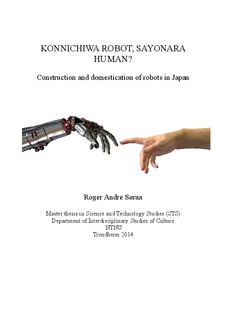| dc.description.abstract | This thesis explores the robots of Japan in a historical and cultural context, to see
how they are co-produced among a wide variety of actors in a network. It is seen both
from the creators' side, through their scripting of what a robot should be understood
and used as, and also from the user-side, through domestication of the robots. I focus
on how the concept of “boundary-objects”, have developed through Japanese history
and laid the foundation for robot acceptance. Different understandings of the concept
“robot” has been constructed through a cultural-, religious- and social-historical
context, leading towards the science fiction representations of robots in manga and
anime. Japanese people living today have read about and seen robots in fiction all
their lives, a fictional script that has lead the engineers and inventors of real robots.
In order to understand the robots in the Japanese society, I decided to seek them out,
and have thus done one year of field-work in Tokyo and Osaka, in Japan.
Methodologically, the thesis draws on observations and interviews in laboratories and
science museums. How the people working on robots think about them are crucial in
order to understand the robots themselves, and how people act around robots is
greatly affected on the amount of “humanism” they perceive the robot to have. I also
explain how it is to control a robot-twin, and see the challenges it raises when “he,
she and it” becomes intermingled, and the gender and linguistic questions it arises
when talking to and about robots.
Lastly, I follow the robots out of the laboratories, and into society, to see how they
affect users as a welfare-technology. Japan is a rapidly aging society, and in dire need
of manpower, especially in the welfare sector. One solution is to use robots for certain
tasks, such as fetching of medicine, walking assistance and cuddles. How the elderlyusers
accept and domesticate robots tells us a lot on what roles the robots can and
can-not do, and also how they can be developed further. Constructing an identity of a
robot nation thus consists of many elements that together co-produces the network at
large, with an underlying cultural acceptance of boundary-objects, such as robots. | nb_NO |
